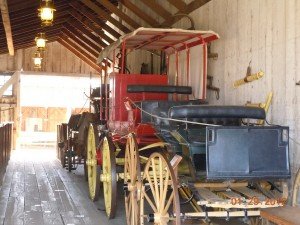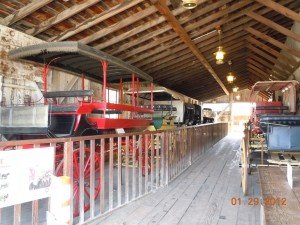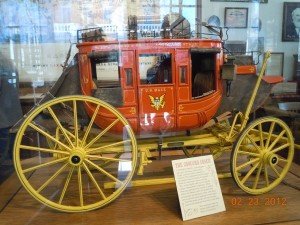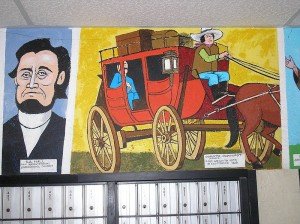Stagecoaches came in a variety of styles. Some as just open carriages. The stagecoach of course most of us is more familiar with is the famous Concord Stage. This is the coach that many associate with Wells Fargo. This will give you an idea of the Concord Stagecoach. The coach weighed about 2,500 lbs. Amazingly, the coach could carry eighteen people. This configuration would place nine inside and nine on top of the stagecoach. The wood used in it’s construction was both ash and oak and generally four to six horses were used to pull the coach.

Making the Westward Journey by Stage
Much has been written about stagecoach travel during the old west days. Mostly it’s been depicted as none too comfortable. This is probably an accurate description especially if you’ve read some of the observations put down on paper by Mark Twain and a few others. His experience occurred about eight years before the transcontinental railroad was built. The stagecoach was about the only choice a person had to travel westward aside from horse riding alone or joining a wagon train.
Mark Twain, in his publication “Roughing It“, which describes he and his brother Orion’s stagecoach journey from St. Joseph Missouri to Carson City Nevada in the summer of 1861, gives one an understanding of what was involved in making the trip. Here are a few excerpts from Mark Twains journal…

“Our coach was a swinging and swaying cage of the most sumptuous description – an imposing cradle on wheels”.
“We began to get into country, now, threaded here and there with little streams. These had high, steep banks on each side, and every time we flew down one bank and scrambled up the other, our party inside got mixed sowewhat. First we would all lie down in a pile at the forward end of the stage, nearly in a sitting posture, and in a second we would shoot to the other end and stand on our heads”.
Stage Lines on the Old El Camino Real
Western Trips came across an interesting site in California which still displays advice given to stage coach travelers over a century ago by newspapermen. This display is showcased at the old San Juan Bautista California livery stable, the Plaza Stable, built in 1861 and which once served as the stop for the stagecoach. In fact, San Juan Bautista was established as both a settlement and mission by the Spaniards directly on the old El Camino Real “The King’s Highway”. Because of it’s location, San Juan Bautista at one time had as many as seven stage lines passing through it.Most of the traffic was going between San Francisco and Los Angeles but also a fair amount to Monterey, Watsonville and Santa Cruz on the coast.
Also, see our articles on the Black Canyon Arizona Stagecoach Line …Riding on the Butterfield Stage Route and The Woman Called Calamity Jane

Visiting San Juan Bautista California
Today, the Plaza Stable is preserved as a museum which houses a variety of carriages, wagons, harnesses and other stable gear. San Juan Bautista, being only about 93 miles south of the center of San Francisco and also directly on the way to the popular Monterey Peninsula, is a great place to add to your California trip planner. If you’re heading out from the San Jose area it’s obviously much closer. San Juan Bautista is also home to Mission San Juan Bautista which is a very popular tourist site.
You’ll find an interesting photo article about Mission Juan Bautista on our Western Trips site.
Advice For Stagecoach Travelers
Travel advice and tips during the 1870’s was scarce and even scarcer when it came to traveling by stagecoach in the west. Newspapers generally took the lead in informing it’s readers about stage coach happenings.

In this endeavor, the information below was first published in the Omaha Herald newspaper, on October 3, 1877. Keep in mind that a stagecoach trip in many instances could be a long journey, not necessarily to the next town down the line. Because of this, there could be a variety of occurrances along the way, some okay and some not as okay. The advice given out by the Omaha newspaper was probably the result of either people desiring to know what to expect traveling by stagecoach and/or the stage lines themselves asking the paper to inform it’s readers so as to make the journey easy on all parties involved.
The published information is as follows:
“The best seat inside a stage is the one next to the driver. Even if you have a tendency to seasickness when riding backwards, you’ll get over it and will get less jolting and jostling. Don’t let any “sly elph” trade you his mid-seat.
In cold weather, don’t ride with tight-fitting boots, shoes, or gloves. When the driver asks you to get off and walk, do so without grumbling. he won’t request it unless absolutely necessary. If the team runs away, sit still and take your chances. If you jump, nine times out of ten you will get hurt.
In very cold weather, abstain entirely from liquor when on the road, because you will freeze twice as quickly when under its influence. Don’t growl at the food received at the station: stage companies generally provide the best they can get.
Don’t keep the stage waiting. Don’t smoke a strong pipe inside the coach. Spit on the leeward side. If you have anything to drink in a bottle, pass it around. Procure your stimulants before starting, as “ranch” (Stage Depot) whiskey is not “nectar”!

Don’t swear or lop over neighbors when sleeping. Take small change to pay expenses. Never shoot on the road as the noise might frighten the horses. Don’t discuss politics or religion. Don’t point out where murders have been committed especially if there are any women passengers.
Don’t lag at the wash basin. Don’t grease your hair, because travel is dusty.
Don’t imagine for a moment that you are going on a picnic. Expect annoyances, discomfort, and some hardship.
Expect the Unexpected
Not exactly a twenty-first hiking guide, but the article above appears to have been printed in an honest effort to make the journey as comfortable as possible for all passengers. Much of it pertains to issues of how to get along with your fellow passengers as well as the driver, usually referred to as the “whip”.
There were so many variables coming into play during a stagecoach journey that most advice can be summed up as “expect the unexpected“. To be sure, not every journey was horribly difficult. Just as in today’s news, the extraordinary is what gets publicized the most. By the same token, traveling by stagecoach was quite different from rail travel. That’s one of the reasons that the railroad brought more people west and created towns all along it’s way.
In addition to the Plaza Stable at San Juan Bautista, a lot of information about the old west stagecoach can be found at any one of the Wells Fargo museums such as the one in Old Sacramento and San Diego California. Also, you can view the old Deadwood Stagecoach at the Buffalo Bill Museum in Cody Wyoming.
(Stagecoach and San Juan Bautista photos from author’s private collection. Charley Parkhurst Mural and Overland Stage Line stamp from the public domain)
